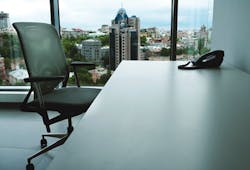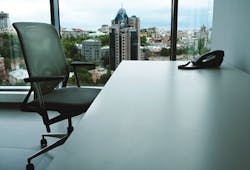A New & Better Way to Calculate Daylight
What qualifies a building as daylit? Could a room with just a single window be considered a daylit room? Or, should a room with floor-to-ceiling windows on all four sides be considered daylit? These are legitimate questions that are being asked by developers, owners, architects, and facility managers as the focus of green-building design shifts to daylighting.
There are two main reasons to bring daylight into a building: energy savings and human well-being. Lighting uses more energy in a typical commercial office building than any other single use (more than HVAC systems, computer equipment, etc.). Through the use of automatic controls (daylight harvesting), daylight offers the greatest potential to provide lighting energy and energy demand reduction during peak utility hours. Bringing daylight into a building so that it displaces electric lighting and provides sufficient illumination is one of the greenest ways to light a building today. When designed correctly, the lighting energy savings from turning off or dimming electric lights, and the resulting reduction in cooling loads, can offset additional heat gains or losses through the glazing to provide net-positive, whole-building energy savings.
While energy savings can be reason enough to promote daylighting in buildings, there is also growing evidence in the field of natural sciences that suggests a connection between daylight and human health. Studies have shown evidence of better student performance in daylit buildings, along with better productivity for office workers who have access to views and daylight during work hours. Exposure to daylighting during the day (and exposure to darkness during the night) has been shown to be directly linked to immune systems and health. As people spend more and more of their days indoors, the need for exposure to daylighting during the daytime is becoming even more important.
Measuring Daylight
So, how do you define a daylit building? To answer this question, there needs to be a metric to measure daylight, and a definition of criteria for acceptable daylight performance.
The most commonly used metric for measuring daylight in a building is called the "daylight factor"—expressed as a percent of available exterior daylight. Daylight factor is defined as a ratio of interior illuminance at a horizontal point in a building to the un-shaded exterior illuminance on a horizontal surface under a fully overcast sky (a ratio of outside illuminance over inside illuminance). The higher the daylight factor, the more natural light that is available in the room.
With its origins in 1909 as a means to establish a minimum legal daylight requirement, this technique of using a ratio instead of absolute values, and using a simplified overcast-sky condition, were used to avoid the difficulty of having to deal with frequent and severe fluctuations in the intensity of daylight. Leaving out these fluctuations in daylight condition that occur over a typical year, and the absence of illuminance from direct sun, are the two harshest criticisms of the daylight-factor metric today. Providing information on daylight performance of a building in an "ideal" overcast-sky condition, which may only occur for a few hours in a year, provides, at best, only a snapshot in time. Daylight, however, is dynamic, and a tool to assess daylighting performance of a building design requires a dynamic daylight metric.
Clearly, a static metric such as this was never meant to be a means of measuring or quantifying daylight design, but was meant as a minimum legal daylight standard; however, over the last half-century, due to the lack of a standard, universally accepted dynamic daylight metric, daylight factor has been the default metric over which criteria for acceptance of daylight performance has been created. Why is this important? One good example: The U.S. Green Building Council's LEED rating system, in its Indoor Environmental Quality Credit 8.1, requires a minimum of a 2-percent daylight factor.
Limitations of Current Daylight Metrics
One of the limitations of using daylight factor as a minimum performance metric: It gives the message of "the more daylight, the better" without providing any guidance on restricting discomfort from direct sun's glare or overheating/excessive heat loss due to the increased glazing.
Another limitation is that, since illuminance from direct sun is not considered in the calculation of daylight factor, it's invariant to building orientation or location. So, a given building design with glazing facing west in Seattle or facing south in Miami would have the same daylight factor. Daylight factor is almost insignificant in a sunny or partly sunny climate. As a result of these shortcomings, many well-known daylight-enhancing features, such as light shelves, do not appear to be beneficial in a daylight-factor analysis. Light shelves are designed to reflect direct sun to the ceiling, converting it into useful, diffuse daylight and pushing it deeper into the building. But, since an overcast sky has no direct sun, a daylight-factor calculation will show a light shelf as something that gets in the way of providing more daylight.
To address the shortcomings of the current metric used to measure daylight, the New York City-based Illuminating Engineering Society of North America's (IESNA) Daylighting Subcommittee was created to guide the development of dynamic daylight metrics and acceptable performance criteria. The hope is that a more sophisticated and universally accepted set of metrics will facilitate widespread promotion and use of daylighting in buildings. Once acceptable daylight performance is better defined, voluntary programs, energy codes, and building standards will be able to specify minimum daylighting requirements.
Creating a New Daylight Metric
In support of the goals of the IESNA Daylighting Subcommittee, the California Energy Commission's Public Interest Energy Research (CEC-PIER) Program, the Northwest Energy Efficiency Alliance (NEEA), and the New York State Energy Research and Development Authority (NYSERDA) have funded a suite of projects with the aim of developing a new daylight metric. This is a multi-year effort, expected to be completed in 2010. The team is headed by the Fair Oaks, CA-based Heschong Mahone Group Inc., with members from various research and educational organizations from the United States and abroad, such as the Integrated Design Lab at the University of Washington, Seattle; the National Research Council Canada, Ontario; Massachusetts Institute of Technology's Department of Architecture, Cambridge, MA; the Integrated Design Lab at the University of Idaho, Boise, ID; and Loisos + Ubbelohde Associates, Alameda, CA.
Recognizing limitations of the daylight-factor metric, various researchers have proposed a number of dynamic daylight metrics, such as Daylight Autonomy (Association Suisse des Electriciens, 1989), Useful Daylight Illuminances (Nabil and Mardaljevic, 2005), Continuous Daylight Autonomy (Rogers, 2006), etc. With recent advances in computer simulation, daylight predictions can be done at an hourly time step across a full year. These new metrics make use of hourly annual simulations of daylight illuminance. These simulations use typical mean year (TMY2) weather files for daylight illuminance for each specific location. This approach addresses the two main shortcomings in the daylight-factor metric: the use of only one overcast-sky condition, and no consideration for location and orientation. It also ensures that specific weather conditions, which may be unique to a location, are captured in the analysis; the guidance from the resulting metric will also be specific to that particular climate and design.
Unlike metrics developed in the past, which primarily calculate illuminance sufficiency, one of the goals set forth for a new metric is, in addition to illuminance sufficiency, to have the ability to describe visual quality in the space.
The team's approach to developing this new metric is to survey a range of daylit spaces that cover a variety of daylighting approaches and are spread across the country in a variety of climate zones. The team has identified and surveyed 61 spaces across five major U.S. metropolitan regions: Sacramento, Seattle, San Francisco, Albany, and New York City. Each study space is evaluated for its daylighting condition by occupants of those spaces, as well as a group of daylighting experts, via a survey that asks them to rate the space on a scale of 1 to 10. The survey captures various dimensions of daylight in the space, ranging from sufficiency (Can you work happily in this room with all the electric lights off?) to emotional response (Do you find the space visually attractive?) to identifying the extent of problems, such as glare (Are you able to work here without any problems from glare or troubling reflections?).
The next step is to develop 3-D computer models for each of these spaces, and then to run daylighting simulations. Various dynamic daylight metrics proposed earlier, as well as a few new ones, will be calculated from these computer simulations. The qualitative assessments collected from the occupants and experts for each space will then be compared to outputs from the computer simulations. With this approach, using statistical analysis of the collected data, the team will develop quantitative and qualitative metrics that capture the most useful descriptors of annual daylight performance in the spaces. The same data will also form the basis for an acceptance criteria for daylighting performance.
With the advent of a universally accepted dynamic daylight metric and performance criteria from this project, you could then answer the question we set forth at the beginning: What qualifies a building as daylit?
While the new metric will provide key input for the buildings industry to evaluate daylighting, the most valuable outcome of this new metric will be a better understanding of the annual quantity and quality of daylight in buildings, moving daylight forward in the direction of more widespread use and acceptance.
Mudit Saxena is a senior project manager at the Heschong Mahone Group Inc., Fair Oaks, CA, and is heading the project to develop a new daylight metric. Saxena can be reached at [email protected].

